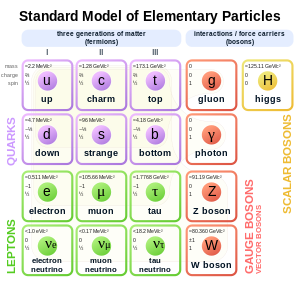 |
| Source: PBS NOVA, Fermilab, PDG |
Anyway, you may also have realized that there are three 'kinds' of 'stuff' represented by the different colours: purple, green and red. All the matter we can see, feel and detect so far (observable) are made from the 'elements' in the diagram. The ones in the purple box, physicists call them quarks, green ones leptons and red ones exchange particles. For example the proton, which makes up part of an atom's nucleus is made from two u-quarks and one d-quark. The neutron, is made up of one up-quark and two down-quarks instead. Then we also have electrons that usually orbit around the nucleus of the atom. Electrons belong to the lepton (green) group.
Now, we have only talked about baryons (subatomic particles that consists of three quarks or antiquarks). In 1935, Hideki Yukawa theorized the existence of the mesons as exchange particles for the strong nuclear force. This idea was proven to be not true as the real exchange (or carrier) particle for the strong nuclear force is the gluon. The first mesons (made from only two quarks or antiquarks), the pions (made from an u-quark and d-antiquark) was found in 1947 by Cecil Powell, César Lattes, Giuseppe Occhialini et.al. from cosmic rays. Subsequent experiments detected charged pions and the neutral pion.
The strong nuclear force is mediated by the gluon between quarks and antiquarks in the proton, neutron for example. They bind the quarks together so hard we never get to see any 'naked' quarks in nature. Everytime you pull the quarks apart and when you think you put in enough energy to split them, they convert that energy into a quark-antiquark pair and you get two mesons or baryons.
 |
| Pulling on the quark pairs in mesons create even more mesons, resulting in a mess (jet) of particles. Source: Wikipedia |



No comments:
Post a Comment